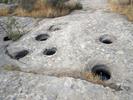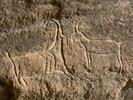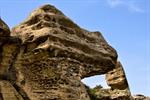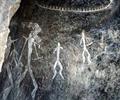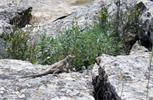Gobustan occupies the south-eastern spur of the Great Caucasian Range and lies west of the Apsheron Peninsula in the basin of the Jeirankechmez between the mid-channel and lower reaches of two other river: the Pirsagat and the Sumgait. It is a monticulate semi-desert area dissected by numerous gullies and ravines. The climate of Gobustan is dry subtropical, the soil is clayey and partly salinized.
The first rock drawings in Azerbaijan were discovered in 1939-1940 in the southeastern part of Gobustan (Mts. Beyukdash, Kichikdash, and Jingirdag, and Yazily Hill) some 50 - 60 kilometres southwest from Baku in the vicinity of Sangachaly and Duvanny railway stations situated not for from the Caspian Sea. The mountains there are separate elevations straggling among mud volcanoes, which are called "pil-pile" by the local people. These volcanoes periodically erupted in ancient times throwing out millions of tons of mud and billions of cubic metres of combustible gases, which blazed up from every spark caused by a collision of flying stones. The sudden appearance of gigantic columns of flame, the deafening rumble, the clouds of smoke shading the daylight inspired the aborigines with awe and fear. These natural phenomena, which could not be explained in the remote past, favoured the emergence of many places of worship in this area. During the Middle Ages some of them were changed to the Moslem religion.
The upper plateau of Mts. Beyukdash and Kichikdash is covered by a bed of shell limestone 10 - 15 metres thick, which is characteristic of the Apsheron rocks. The upper plateau of Mt. Jingirdag is also covered by shell limestone but only 1-2 metres thick. In the course of ages these limestone beds fractured and split into fragments under the action of natural forces, atmospheric precipitation, wind, etc., and covered the slopes (predominantly eastern ones) and feet of the mountains dotting them with numerous large and small blocks and piles of limestone. During the same period of time big scarps about 10-15 metres deep occurred round the tops of Mts. Beyukdash and Kichikdash. Later the tops of these mountains were used by local inhabitants as natural traps when hunting. Piles of stones looking like huge labyrinths appeared in some areas among the "sea of rocks" giving the stranger a sensation of mysterious fear.
On the clumpy rocks one can see whimsical aeolian relief forms, hollow mushroom-like jointings, some of them with through openings, many of them even with smooth surfaces and lace and honey-comb patterns. They can all be rightfully regarded as classical specimens of geological and natural phenomena of this type.
It was here, in the area of this fantastic destruction of mountains, in the 'sea of rocks', sometimes under the heaps of stones (e. g. in the vicinity of Mt. Beyukdash) that some 20 under rock caves and rock shelters were formed, which could protect people from bad weather. Since time immemorial and up to the beginning of the 20th Century the local population used to cover the stone blocks near the caves and the walls of the caves with images of human beings and animals and various signs. They hollowed semispherical bowl-like depressions to collect rain-water and sacrificed blood, and chopped holes to tether domestic animals. Now some of these stones are covered with lichen, greenish-gray, sometimes with large reddish-ochre or silvery white patches, under which vague drawings are barely visible in the slanting rays of the sun.
The rock drawings in the area of Mts. Beyukdash, Kichikdash and Jingirdag and Yazily Hill have been studied since 1947. A colossal number of rocks were investigated. Some 750 of them revealed drawings and signs on their surfaces, which had been carved with stone implements and, sometimes, with metal tools. More than 3,500 drawings have been discovered and recorded.
These rock drawings dating back to remote centuries suggest that the climate of Gobustan in the distant past was damp and close to subtropical. This is evidenced by the pictures of people wearing loin-cloths as being typical of the inhabitants of tropical countries, and also by the representations of bulls, deer, and pigs whose existence is impossible without perennial water reservoirs and rich pastures. Rainfall was heavy enough in those ancient times, rivers and springs abounded in water, the herbage of the area was rich and diverse. An abundance of food made it possible for countless herds of herbivorous animals to graze in the pastures of Gobustan.
The rock drawings of Gobustan are very diverse as to their themes and content. Among them one can find pictures of human beings, wild bulls, deer, bezoar goats, lions, gazelles, horses, wild asses, some of them being nearly life-size. Some of the animals are of unidentified species. There are also drawings on some rocks, representing collective labour processes, reaping, sacrifice, hunting scenes, fighting goats, dogs chasing a wolf and a deer, lions attacking goats, abduction of women, battle scenes, camel caravans. Outline drawings of large sized fish were also discovered on the rocks.
Quite a number of drawings represent boats with both armed and unarmed oarsmen and with an image of the sun on their bows. Discovered on the rock was a picture of a two-wheeled araba (bullock cart) The pictures of single and group ritual dances resembling a modern Azerbaijanian dance, the Yally, have also been spared by time. Some of the drawings represent an outline of a human foot and a relief arch, which were probably of some ritual importance. Drawings are also registered representing snakes, lizards, swastikas, crosses, solar signs, tamgas (stamps), inscriptions in Arabic letters, etc. On the surface of several large stone blocks one can find separate groups of depressions (7, 10 or more in each group) 2-3 cm deep and 6-10 cm in diameter. They were possibly used for a game similar to a national table game known among the local population as "Ev kechdu" (changing the house), "mere-mere" (game with holes), or "pula-pula" (sheep's droppings). Depicted on three big stones are small rectangles divided into relief squares and looking like a draught-board. They are called "dama-dama" and were most probably employed for a more involved table game resembling draughts.
A very attractive relic of the past is so called "gaval chalan dash" (tambourine stone), an ancient percussion musical instrument.
One of the rocks bears a Latin inscription dating back to the reign of the Roman emperor Domitian (81-96 A. D.), which denotes the sojourn of the 12th Roman Legion led by Fulminate on the shores of the Caspian Sea.
Of the rocks mentioned above, 120 are represented in this book by 135 expositions comprising a total of more than 1,500 separate pictures. Each of these pictures has been described and tentatively dated. The expositions represent unique and valuable complexes of drawings distinguished for the variety of themes and content and are of great scientific, historical, and artistic importance.
The carefully selected expositions enable the reader to get acquainted with all types of drawings, their meaning, style of performance, design of human figures and animals, compositional solution, and carving technique. The contour lines (grooves) of the drawings are some 10 to 50 mm wide and I to 30 mm deep. Some of the drawings are bounded by scarcely visible contour lines, which have been smoothed off in the course of time. The silhouette drawings are about 2 to 10 mm deep. Certain silhouette pictures of men, some 20-30 mm deep, look like a kind of relief depressions in the rock.
A thorough and detailed study of Gobustan's rock drawings, particularly their overlapping and also their style, themes, way of composition, and technique of performance as well as comparison with similar dated rock drawings in this and other countries allow the following suggestions about their dating:
1. The earliest period is responsible for almost life-size silhouette representations of men and women full face and in profile in standing and squatting positions with bows over their shoulders. The women are naked, with big bosoms, narrow waists, wide hips, and thick legs; they have no arms though they carry/wear bows. The men in loin-cloths have tall and slender bodies, their strong legs with well defined muscular calves are slightly bent and planted wide apart. Their arms are marked with thin straight lines. In many pictures they have a kind of weapon, resembling an axe or a knife, in one or both hands. Heads and necks of the men and women are represented as short spikes.
These human figures were carved when the climate in Gobustan was most probably tropical and its landscape resembled that of a savannah with rich flora and fauna.
Using the available data as the base, these drawings were dated as far back as early Neolithic stage, i.e. the period from the 8th to 6th millennia BC, when mother was the head of the family commune.
2. The silhouette drawings of human beings are followed by life-size contour pictures of wild bulls, some of them about 240 cm long and about 140 cm high. Most of these drawings were discovered near Mt. Beyukdash, none of them were found in the vicinity of Mt. Jingirdag and Yazily Hill.
Big and also smaller contour drawings of wild bulls and small pictures of people wearing loincloths and armed with bows are dated as belonging, to the period from the 6th millennium to the verge of the 3rd millennium BC when hunting still retained its leading position in the life of man. The pictures of boats with the image of the sun in their bows are also dates back to that period. Along with the pictures of bulls, they were only found in the rear of Mts. Beyukdash and Kichikdash.
3. The big drawings of deer, some 180 and 120 cm long and 110 and 85 cm (and slightly smaller) in height, were carved in the early neolithic and somewhat later, i. e. in the 4th - 3rd millennia B C, and strike the onlooker with the skill of their performance. These profiled pictures are remarkable for their vividness, irreproachable preciseness of proportions, dynamic representation of motion. The animals have slender bodies and graceful heads and necks. Their big antlers are often drawn full face. The poses of the animals express inner strength. These pictures were undoubtedly represented from life.
No less beautiful are the drawings of gazelles and bezoar goats. They are always depicted in profile. The oldest of them are bigger than life-size (up to some 240 cm long and 160 cm high).
The pictures of goats and, more rarely, deer and horses are crossed by straight furrows dividing their bodies in the middle or cutting off their heads or other parts of the body. The existing ethnographic parallels give good grounds to assume that these furrows were of ritual significance; the primitive people imagined that they would bring them good luck during hunting expeditions.
In the neolithic and Bronze Age the representations of animals and people came to be gradually transferred to ceramic and metal articles.
4. In the Bronze Age and later the rock drawings of Gobustan began to show an increasing tendency to be diminished in size. The technique of drawing was changing: the realistic manner of representation was preserved only in some instances. Silhouette pictures of human figures tended to be replaced by linear ones. Representations of gazelles, horses, pigs, dogs, and other animals, including beasts of prey, are common among the drawings of that period.
As a result of using improved tools made of bronze, developing cattle-breeding, and cultivating land, hunting gradually lost its significance in the life of local inhabitants. Since the end of the Bronze Age (2nd millennium B. C.) and later, hunting was predominantly an occupation of the tribal nobility. These persons were frequently represented on horseback.
Due to decreasing importance of hunting in the life of local people, the ritual furrows on the drawings representing animals were gradually losing its meaning and vanished in the passage of time. However, hunting still assumed a significant place in the economy and was represented in many drawings. The people armed with bows and arrows, spears, tridents, swords, lassos, and bolos were hunting on foot and on horseback, using dogs and birds of prey as well as various appliances, such as traps.
5. In the period from the Iron Age (2nd3rd millennia B. C.) and up to the beginning of our era, the rock drawings continued to diminish in size. The shapes of the animals, however, retain their correctness in many cases.
The ritual furrows on the pictures of animals became very rare. 6. In the Middle Ages (8th-Ilth century A. D. and somewhat later), in view of ever decreasing economical importance of hunting, more frequent transfers of the pictures onto ceramic and metal articles, and negative attitude of the Moslem religion to representation of human beings and animals, the drawings on the rocks of Gobustan became even more outlined; they were drawn in straight lines only and resemble distorted geometrical figures. They changed their shape and, at times, became meaningless. The then artists hardly followed nature. The pictures became even smaller in size. Traces of metal tools that were used to carve the drawings can be easily discerned but some of the pictures were also cut with stone implements.
Most of the drawings of this period merely imitate the ancient rock drawings. They were possibly carved by shepherds in their spare time without a definite aim. This manner of representation was preserved in Gobustan up to the end of the 19th century and, in some cases, even later.
Characteristic of the mediaeval period are also drawings representing camel caravans and horsemen armed with swords and spears, A major part of signs, tamgas (stamps) and Arabic inscriptions also date back to this period.
The rock drawings of Gobustan occupy a prominent place among the similar cultural monuments of Karelia, Siberia, Central Asia, and other parts of the U.S.S.R. Many of them possess quite a number of common features with kindred rock drawings of Scandinavia, the Pyrenees, and Africa.
The rich heritage of ancient culture situated in the south-eastern part of Gobustan along with natural remnants of the past in this area is,,of paramount importance for many domains of science, such as geology, botany, pedology, etc. In total this complex constitutes a valuable museum in the open air ranking high among the other reserves of All - Union importance.
The monuments of Gobustan are really worth seeing with one's own eyes. For a wise popular proverb has it: "He knows much who has been everywhere and seen much, but not who has only read much".
If you're planning a trip to Azerbaijan you may be interested ▶ Azerbaijan highlights - For those who prefer to go unbeaten path, to explore less visited places and check national charisma of this small country in Southern Caucasus on the edge of Europe.



